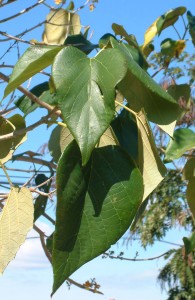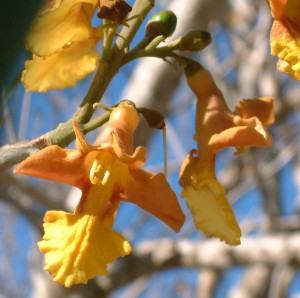Tree Mining, Cardboard Boxes, & Poison Sawdust
By Jack Ewing

Carpenters, builders and sawmill operators love it; chicken and pig farmers hate it; and environmentalists have mixed feelings about it. I have heard people say that the gmelina tree (Gmelina arborea) is a plague that should be eradicated from the face of the earth, yet others believe that it is a miracle tree with great potential for the recuperation of ecosystems and the environment. Regardless of what you believe about the gmelina tree – native to southeast Asia – the story of how it got to the Americas and how Costa Rica came to plant 25,000 hectares of it, is a fascinating tale.
I first learned of gmelina in the early 1980s from an article in The Economist magazine. It told of a wealthy investor named Daniel Ludwig, who had determined that the world would soon be facing a severe paper shortage. In order to capitalize on the situation, he purchased one million acres of land in the Amazon jungle near the Jari River. Next, he contracted with a Japanese firm to build a paper mill mounted on pontoons. He then hired some monster tug boats to tow the mill from Japan, across the Pacific Ocean, around the tip of South America, up the eastern coastline of the continent, into the mouth of the Amazon River and up the Jari River to the point where he expected to operate it. The plant was too big to pass through the Panama Canal. The plan was to cut the existing forest, process the trees in the paper mill and plant gmelina trees on the denuded land. The gmelina trees were fast-growing, made excellent paper pulp, could be harvested after only six years and then grew right back again.
Twenty-five years after I read that article, a couple from Brazil, Gilberto and Carolina, stayed for a week at Hacienda Barú Lodge. I soon discovered that Gilberto was a forester and had worked on the Jari project with Daniel Ludwig. I learned that Ludwig had been a common laborer until he was sixty years old, at which time he invented what he called “tree mining.” He perfected a technique for recovering valuable lumber, mainly white pine, from the bottom of the great lakes. The enormous trunks were perfectly preserved and extremely valuable, and there were untold numbers of them just waiting to be mined. That was the beginning of Ludwig’s great fortune. Two decades later, when he began the Jari project, Daniel Ludwig was worth about three billion dollars.

“Whether you agreed with his ideas or not, you couldn’t help but admire him,” commented Gilberto. “Daniel worked harder than any of us. He brought his lunch, a banana and a slice of cheese, in a brown paper bag, and his lunch hour lasted only five minutes. He ordered us foresters to plant 10,000 acres of gmelina that first year. I told him that it was a big risk, that we didn’t even know if gmelina would grow in Brazil. I suggested we plant only 1000 acres. ‘Listen Gilberto,’ he told me, ‘I’m 81 years old. I don’t have time to find out if gmelina will grow here. Plant 10,000 acres.’ So we did.”
Eventually the Jari Project ran into insurmountable problems. The Brazilian government had originally promised that Ludwig could build a large hydroelectric plant, imperative to the operation of the mill, on the Jari River. However, when it came time to begin building the dam, the government reneged on its promise. Ludwig walked away from a project into which he has sunk more than one billion dollars. The Jari River project was eventually taken over by a consortium of Brazilian investors.
In 1989 in southern Costa Rica, some people came to Hacienda Barú looking for land to lease. The company was called Ston Forestal, and they were offering three contract options: a six-year lease, a twelve-year lease, or an eighteen-year lease. The longer the term, the higher the price per hectare per year. They planned to plant gmelina trees on the land and harvest them every six years. The freshly cut stumps quickly sprouted new shoots which grew right back. The trees were destined to become paper pulp. We turned down their offer at Hacienda Barú, but lots of other property owners signed the lease contracts. Estimates of how much land was eventually planted to gmelina in Costa Rica vary from around 25,000 hectares to over 50,000 hectares, all of it in the southern zone. The real figure is probably closer to the lower estimate.
The gmelina tree is not particularly large, but can reach a height of around 20 meters (65 ft.) in less than ten years. Though extremely fast growing, it is short lived, and usually dies and falls over after only 30 to 40 years. It produces a yellowish fruit, about the size of a cherry, which is eaten by cattle, horses, toucans, monkeys and several other birds and animals. It prospers in well drained areas at altitudes from sea level to 600 meters (1950 ft.)
In India, where the gmelina tree is native, the leaves, which contain about 12% protein, are reported to make good fodder for cattle. As the Indian people have lived with these trees for centuries, they have discovered many medicinal uses, most of which are derived from the roots and bark. These include treatments for: constipation, intestinal parasites, headache, stomach ache, urinary discharge, ulcers, vaginal discharge, and even snake bite and scorpion sting. Many Indians have a gmelina tree or two in the garden for personal medical use, and they are often seen growing along the city streets. As the plant grows naturally in many southeast Asian countries, it has many common names including gmelina, gemelina, melina, yemane, gumhar and white teak. The tree was named after a German botanist named Johann Georg Gmelin, who first described the species, Gmelina arborea.
In the area around Dominical, many property owners from Ojochal to Matapalo turned their land over to Ston Forestal, who promptly planted gmelina trees on terrain that had formerly been used for pasture and agriculture. The trees grew at an impressive rate and soon became a common sight both along the main roads and also in more remote areas. Due to unforeseen circumstances having nothing to do with the gmelina tree, Ston Forestal never harvested these plantations.
As mentioned earlier, the gmelina cultivated in southern Costa Rica was destined to be made into paper. Ston Forestal was a fully owned subsidiary of Stone Container Corporation, which is headquartered in Chicago. Stone Container is a large corporation with over 60 subsidiaries who own and operate upwards of 30 paper pulp mills, 15 wood product mills and 120 corrugated container (cardboard box) plants. They control over 11 million acres of natural forests in Canada and nearly 2 million acres in the United States. The eventual bankruptcy of Ston Forestal and the departure of Stone Container Corporation from Costa Rica, has certain aspects in common with the fate of Daniel Ludwig in Brazil.
The economic success of the gmelina project was contingent on a number of governmental commitments, mainly several substantial economic incentives and the construction of a mill for converting gmelina logs into chips which could be exported for processing in a paper mill located in the United States. It was important for the chipping mill to be located near to a sea port. The proposed site for the port and chipping mill was Punta Estrella, near the community of Rincon, at the innermost corner of the Golfo Dulce. The Ministry of Public Works and Transport (MOPT) was to build the port facilities and Ston Forestal the chipping mill. Neither project was ever to get off the ground.
A number of Costa Rican environmental organizations, with the backing of the international organization Greenpeace, opposed the project from the start. There were a number of reasons, the main one being the damage that it would cause to the marine environment of the Golfo Dulce. After a bitter and hard fought battle, the environmentalists came out victorious, Ston Forestal went into bankruptcy, and Stone Container Corporation left Costa Rica with its tail between its legs.
About 25,000 hectares (61,750 acres) of gmelina were abandoned with the lease contracts still in force. The property owners didn’t know what to do. They were uncertain whether or not they could harvest the wood and sell it, or if it still belonged to the now defunct Ston Forestal. After a couple of years of uncertainty and not receiving the rental due for the land on which the trees were planted, most contract holders decided that the company was in default on their contractual agreement and began cutting and selling the wood. At first everybody thought gmelina wood would be useless for anything but paper pulp or maybe concrete forms, but this was not the case. Gmelina is a blondish colored wood resembling pine. It is strong, yet easy to mill and finish. It is ideal for construction because of its structural strength and natural resistance to termites. The main problem with the plantations was that most of the trees had never been pruned and were, therefore, quite crooked. As they were originally destined to be milled into wood chips, straightness was not a concern, but for lumber the crooked trees were worth much less than straight ones.
Chicken farmers around San Isidro, who have for years used wood shavings as bedding for their chickens, soon found that if they bedded the chickens with gmelina shavings, the chickens would get sick and die. Most veterinarians in the southern part of Costa Rica warn pig farmers and horse owners not to bed their animals with gmelina shavings because of this apparent toxicity. This same phenomenon may be the reason why the wood is so resistant to termites. Nevertheless, I have never heard of a case of a wood worker being affected by saw dust from gmelina trees. I did a pretty extensive search on the internet as well and have been unable to find any reference to toxic properties of the plant or the wood. Perhaps more will come to light on this subject in the future.
President Jose María Figueres called the Ston Forestal gmelina plantations an important example of the process of sustainable development in Costa Rica. Most environmental organizations I know of would tend to disagree. But looking at the situation pragmatically, I’m not so sure that the tree is as bad as some people say. To my knowledge Ston Forestal did not cut any natural forest and replace it with gmelina, rather they planted the trees in pastures and rice fields. The plantations don’t provide much benefit for wildlife, but neither did the pastures and fields that preceded them. Unlike food crops, very little if any chemical fertilizer and pesticides are used in the production of gmelina. From the beginning of the project, the forestry department refused permission for Ston Forestal to plant on excessively steep hillsides, and possibly because of this restriction, soil erosion has not been a serious problem in gmelina plantations. Finally, I have seen no evidence that the gmelina plant is invasive. In other words, it has not demonstrated a tendency to take over the land and choke out other vegetation. If we consider the ecological balance sheet regarding gmelina plantations throughout the southern zone, I think we can say that it is probably no worse than other monoculture tree plantations and somewhat better than the land usage it replaced. Nevertheless, a mixed plantation of native species would have been preferable ecologically and the regeneration of natural forest better yet.
Regardless of whether you think gmelina is a miracle tree or the plague of the earth, nobody can deny that it has a fascinating history.

